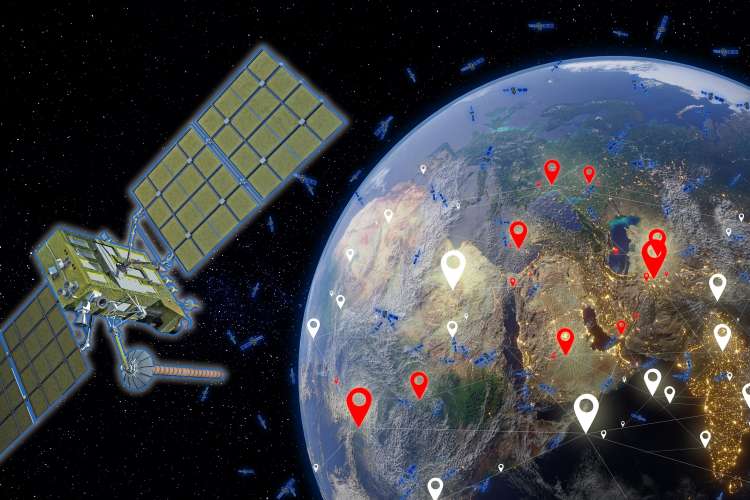Capturing and maintaining a comprehensive understanding of the rapidly evolving space domain is crucial to The Aerospace Corporation’s role in supporting the future of space. In-depth space domain awareness (SDA) relies on large amounts of data informing the success of operations on the ground and in space. Aerospace is helping meet the needs of its partners by leveraging its expertise in SDA as well as its groundbreaking technologies and long-established trust with commercial and government partners.
To meet the need for informed action, Aerospace assembled an expertise driven group called the Spectrum Electromagnetic Interference (EMI), Awareness, and Response (SPEAR) Team, to collect and examine data from a variety of U.S. and commercial space assets, informing actionable responses to national and global GPS and other radio frequency (RF) spectrum disruption events. These experts help detect and create a map of EMI, providing crucial data to inform decisions on the ground. Recently, SPEAR assisted the Continental U.S. NORAD Region - First Air Force (Air Forces Northern & Air Forces Space) Position, Navigation and Timing (PNT) situational awareness tasking efforts during the presidential inauguration, monitoring commercial overhead geolocation collections and analyzing the data collected. Earlier this year, SPEAR also supported crewed missions to the International Space Station (ISS), providing SDA to mission teams during dynamic phases of flight.
Leveraging Aerospace Expertise
“Our challenge has always been how do we transition these capabilities out of labs and sustain them in operations outside of Aerospace,” said Steven Lewis, principal engineer/scientist and SPEAR Director. “But with the SPEAR team we're facilitating an opportunity for industry to leverage FFRDCs and their expertise, as we ensure a successful transition of capabilities to industry and operations without competing with them. This effort alone has led to over 10 commercial companies receiving contracts with the US Government for innovative, game-changing capabilities.”

The SPEAR team supports government agencies such as the National Aeronautics and Space Administration (NASA), the Federal Aviation Administration (FAA), and the United States Space Force (USSF). Within SPEAR, Aerospace provides highly skilled scientists and engineers who drive the advancement of technologies in support of national directives and international goals to move valuable capabilities out of the labs and into operations. With Aerospace’s deep history in monitoring, collecting and interpreting data from space capabilities, these experts leverage Aerospace’s position as a trusted expert to transform data into innovative solutions for its commercial partners and beyond.
“This is a unique opportunity to solve pressing customer needs while leveraging a wide array of internal capabilities, ranging from nontraditional data sources to exquisite ones as well as applying a variety of Aerospace’s data exploitation tools,” said Hagop Jake Chinchinian, a foundational member of SPEAR with expertise in software development, Artificial Intelligence and Machine Learning (AI/ML) algorithms and operations.
To collect and curate the large amount of data gathered, Aerospace experts apply emerging automation technology to assist in performing a rapid analysis of these advanced analytics, detecting change and other insights. The experts utilize data exploitation tools to provide these insights, including but not limited to, Aerospace developed AI/ML programs and Data Exploitation and Enhanced Processing (DEEP) PNT capabilities.
Building on Success: From Pathfinder to SPEAR
The assembly of the SPEAR team builds on Aerospace’s previous accomplishments with massless payloads, including the Pathfinder prototype. Pathfinder was produced at Aerospace with a distinctive group of talent ranging from data scientists, domain experts and software developers—all focusing support to USSF. These experts used commercial, unclassified data from combined commercial constellations, processed it and then visualized where there could be possible manufactured interference. This was the first iteration of SPEAR and established Aerospace’s leadership in implementing these types of massless payloads informed by commercial data. Pathfinder was then effectively transitioned and utilized by industry to support critical decisions.
Applying Talent to Broaden the Impact

Aerospace’s ability to apply its talent, expertise and solutions to provide actionable responses is what uniquely positions it to advise its government and commercial partners on data driven decisions.
“Using combined commercial constellations, our data science team is working with our domain experts to extract meaningful insights from large, complex data sets, enabling end users to visualize this information in a way that provides value,” said Scott Fuchs, senior engineer specialist and USSF SPEAR team lead. “With this collaboration among Aerospace experts, we are helping the government find innovative applications for unclassified commercial data beyond traditional use cases and are able to contribute to the protection of National Air Space (NAS).”
The SPEAR team is not only powered by Aerospace’s reputation of technical leadership and innovative solutions, but also by the individual experts who bring unique experiences to solve the hardest problems in space. This breadth and depth of knowledge continues the advancement of U.S. space capabilities, to keep pace with the demand for innovation.

